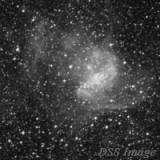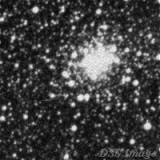Treasures Of The SMC Part V
Back to Treasures of The SMC Index
By Andrew Murrell
If the Tarantula Nebula is said to be the heart of the LMC, then NGC 346 must surely be the heart of the SMC. This magnificent nebula takes pride of place as the premier object in the SMC.
This large nebula is visible with the slightest of optical aid, even the 6x30 finder will show the nebulae. The nebula stands out compared to the other objects in the galaxy. My 90x20 finder shows the nebulae as quite a bright patch with an almost stellar nucleus surrounded by the glow of the galaxy. I have even been advised that some people have seen it with the naked eye. I'm not to sure how accurate those reports are though.
A 4" telescope at low power shows the brightest part of the nebula plainly, peppered with a few faint stars. A small central condensation (the cluster) can be seen but no stars are resolved, even at high power. A UHC filter will do little to help a telescope of this size as it restricts too much of the light. It is better to increase the magnification to increase the contrast. The central bar of the nebula is easily visible with a slight brightening at the southern end. It appears to be about 4 arc minutes across, with a pair of 10.5 magnitude stars close by on the western side making a great low power field. The view changes little by jumping up to a 6'' telescope. The southern end of the nebulae is now noticeably brighter and appears to fan out slightly. An 8'' scope starts to show NGC 346's spiral shape, particularly with averted vision. The nebulae now appears to be about 5 arc minutes across. A 10" telescope reveals a bright bar peppered with faint stars. The arms are now visible with direct vision , all be it quite diffuse.
The UHC filter blocks the stars dramatically but the arms of the nebula are definitely enhanced. Even the faint outer halo can now be seen with averted vision. It is with a 12" telescope that the nebulae really comes to life. The main bar of the nebulae is bright and has a fairly well defined edge. The arms are easily visible without a filter and the outer halo is visible with direct vision. To me the nebula looks better without the filter because the central cluster is easily resolved into numerous stars. The nebula now appears to be about 9 arc minutes in diameter. The spiral shape reminds me of NGC 1300. Eagle eyed observers may note a slight green tint to the centre portion of the nebulae. I myself have not seen this, at least not in a 12" scope.
The view through hector is quite spectacular particularly when you remind yourself that NGC 346 resides in another galaxy. The object is huge covering over 12 arc minutes in diameter. The central bar is bright with a sharp edge and a faint green tinge. The northern end of the bar curls away to the east while the southern end curls west. The northern arm is quite slender and well defined, almost 8 arc minutes long making just under half a revolution. The area inside the loop is dark, adding to the shape edge of the arm. The southern arm is less distinct and quite broad. This arm also curls through almost half a revolution. The inner section of the loop is filled with the ghostly glow of faint nebulae. A faint extension can be glimpsed moving south west from this arm. The cluster in the centre is made up of 12th and 13th magnitude stars. In the centre of the cluster is a small ring of stars surrounded by a box like shape of stars. The entire area is studded by a general scattering of 13th and 14th magnitude stars. The cluster is almost 2 arc minutes across with a good concentration toward the centre. In fact the centre of the cluster appears almost stellar in my finder. Fainter stars in the 15th to 17th magnitude range form a background to the cluster, and appear to be concentrated in the area of the cluster.
The UHC filter drowns out the faint cluster members but the nebula really jumps out at you. The northern arm remains thin and bright and quite well defined, but now the area between the arm and the main bar is lightly shaded by faint nebulae. In the very centre of this area is a small dark crescent. Surrounding this arm is a faint glow that extends about 4 arc minutes away. The southern arm changes dramatically as the arm looses some of its distinctness because the fainter nebulae seems to respond to the UHC filter quite well. The nebula spreads out covering a larger area, the faint extension seen without the filter is now easily visible. The area between the main bar and the arm is now almost completely filled in with nebulae except for a small 1.5 arc minute dark patch. From this dark patch a dark lane can be traced leading back toward the middle of the nebulae. This end of the nebula is also surrounded by a faint halo which extends the size of the nebulae to almost 14 arc minutes across. When this nebula is viewed at the lowest power it appears as a near ring of nebulae with a bright bar across the centre. The northern arm has an even surface brightness, gradually fading as it progresses. The southern arm though varies unevenly across the surface.
During the course of my observations I noticed what appeared to be a small cluster or compact nebula just off the edge of the southern arm. This object was no more than 10 arc seconds in size with the surface brightness of a 12.5 magnitude star. When I observed it using the UHC filter I found that it responded extremely well. I consulted the information that I had concerning the objects in the SMC, but I could not find any reference to it even in the Hodge Atlas of the SMC. I would estimate that this cluster/nebulae would be visible in a good 12" telescope using at least 200x magnification, as any lower and it would appear as a star. Happy hunting.
NGC 330
NGC 330 is one of the brightest clusters in the entire SMC. It is easily visible in a pair of 10x50 binoculars, and can be found 20 arc minutes Southwest of NGC 346. E.J.Hartung described it as "a very bright knot of stars, irregularly round.....in a field sown with faint stars; it is well resolved with sufficient magnification and 7.5cm shows it plainly with some star sparkle.....the stars must be very luminous to be evident in such a remote object".
NGC 330 is about 1.5 arc minutes across and the outer stars are easily resolved in an 8" telescope. The brightest stars approach 12.5 magnitude, and the cluster is fully resolved in a 12" scope. The centre of the cluster shows a strong condensation of stars, with loops and chains of stars leading away, most particularly a chain of stars on the south eastern side. The cluster is easy to pick from the background even though it lies almost in the middle of the cloud. It has an integrated magnitude of 8. This cluster is also interesting in that a number of the SMC's brighter variable stars can be found in the area.
If the telescope that you are using is able to show 1.5 degrees of the sky you may be able to fit NGC 371, NGC 346, and NGC 330 in the one field of view. Be sure to scan around the area as there are numerous other objects in this area that I have not described in this article.
Refer also: Treasures Of The SMC - Table Of Objects



